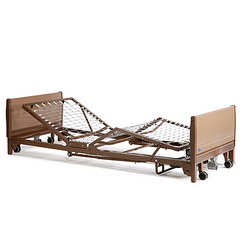The issue about using humane medical bed restraints is highly debated. It also has a somewhat exaggerated context. The only goal with using medical restraints on patients is to prevent them from hurting themselves. In mental health facilities, this may extend to preventing patients from harming attendants and visitors. But mostly, medical bed restraints are used only for the safety of the patient. There are many different types of restraints, and not just the very common strappings. The following discusses those various types, as well as the issues that go along with some of them.

Simple safety restraints
Contrary to the popular belief, medical bed restraints aren't always in the form of straps, belts and buckles. Many of them are used widely and patients don't even know it. A good example is a bed railing. It's important to understand that the restraints are put there only for the safety of the patient. As such, the restraint may be put there to prevent further injuries caused by falls. Inadvertently, the IV fluid and other wires hooked to the patient may get pulled off, causing extreme pain and substantial damage, if the patient stumbles or falls off the bed. For that reason, using bed railings is nearly always compulsory in hospitals.
Strap restraints
Thinking about medical restraints, the first things that come to mind are straitjackets and strappings. Saying a patient is held with medical restraints, however, is tantamount to saying that the patient has some sort of mental illness and is a danger to other people. To a certain degree, that might be true. After all, the use of medical bed restraints is lawfully prohibited, and it can only be done under a doctor's prerogative. Even so, according to US law, restraining a patient due to aggressive and unpredictable behavior may last for only 24 hours. Oftentimes, the patient is simply sedated to avoid using these restraints. Cases in which there is no other option aside from strapping patients are also very rare.
Uses for medical bed restraints
There are various uses for medical bed restraints; though, most of them are done for the sole purpose of seeing to the safety of the patient. The following are some situations where restraining a patient may be necessary:
- The patient shows aggressive, harmful behavior to himself or herself
- The patient shows aggressive, harmful behavior to others
- The patient displays an unpredictable and dangerous disposition
- The patient is severely injured and may fall off the bed
- The patient is not in his or her right mind at the moment
- The patient exhibits unwanted behaviors but can't be sedated
- The patient is experiencing fits of pain that cause him/her to trash and scream
- The patient's behavior somehow risks the hospital equipment necessary for his or her life support
- The doctor may request that the patient is restrained for any other condition in his expert opinion
Lastly, the issue about whether or not medical bed restraints are humane is virtually non-existent. Doctors follow strict protocols and guidelines and will not advise or order the use of restraints if it is not sufficiently necessary.
